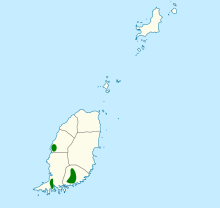格林纳达棕翅鸠
| 格林纳达棕翅鸠 | |
|---|---|

| |
| 科学分类 | |
| 界: | 动物界 Animalia |
| 门: | 脊索动物门 Chordata |
| 纲: | 鸟纲 Aves |
| 目: | 鸽形目 Columbiformes |
| 科: | 鸠鸽科 Columbidae |
| 属: | 棕翅鸠属 Leptotila |
| 种: | 格林纳达棕翅鸠 L. wellsi
|
| 二名法 | |
| Leptotila wellsi (Lawrence, 1884)
| |

| |
格林纳达棕翅鸠(学名Leptotila wellsi),又名威氏棕翅鸠[2],是新世界热带的一种鸽子。它们是小安的列斯群岛中格林纳达的特有种,也是当地的国鸟。它们现时处于极危状况。[1]
特征[编辑]
格林纳达棕翅鸠的喉咙白色,面部及前额呈粉红色,冠及颈背呈深褐色,背部是橄榄绿色。翼底呈粟色,颈及上胸是粉红色的, 下胸、腹部及尾底呈白色。[2]
科学分类[编辑]
格林纳达棕翅鸠最初是于1884年由乔治·纽博尔德·劳伦斯(George Newbold Lawrence)所描述,并被分类在Engyptila属中。[3] 后来于1988年基于超声图象分析而被分类为独立的物种。它们于1991年成为格林纳达的国鸟。[4][5]
分布及栖息地[编辑]
格林纳达棕翅鸠是西印度群岛格林纳达的特有种。[6] 历史上纪录了它们在格林纳达及其离岸岛屿出没[7],而其模式标本则是在西岸的Fontenoy采集。[3]
一些研究指格林纳达棕翅鸠与西部及西南部的干旱森林。[8] 干旱森林的生态系统是更新世末期西印度群岛的遗迹[9][10],但大部分现有所谓的干旱森林都只是退化森林。现时格林纳达棕翅鸠主要栖息在退化的常绿林。[11][12][13] 这些环境的最大问题是非常接近人类居住的环境,并受到城市发展的压力。[11][14][15]
研究显示格林纳达棕翅鸠现正使用3种季节性森林,包括半常绿林、季节性落叶林及荆棘林地。[16] 另外,近年的统计显示它们在分散的半市区及郊区出没。
在格林纳达西南部也有纪录格林纳达棕翅鸠的出没。[8][9][14] 其中Hartman山被认为是它们的代表栖息地。[8] 当中部分被定为国家公园,也是格林纳达唯一的国家公园。它们也有在西部出没。[8][9]
行为[编辑]
繁殖[编辑]
格林纳达棕翅鸠被假设是地盘性的,而现时的数量也是基于此假设来估计。[8][14] 在Hartman山的格林纳达棕翅鸠是会打斗的,而其他棕翅鸠属也有不同程度的地盘性行为。[17] 例如在英格兰饲养的Leptotila verrauxi就曾将其他新来的同属物种杀死。[18]
以往只曾有关一个鸟巢的纪录。[8] 于1月及2月该鸟巢仍然有被使用,并且是筑在棕树上。幼鸟也有在地上活动。[14] 饲养的Leptotila verrauxi是会在受到骚扰的情况下放弃鸟巢[18],而它们的鸟蛋是呈淡黄色的,每次会生2只蛋。[17]
食性[编辑]
格林纳达棕翅鸠是会在地上觅食的。[14] 饲养的Leptotila verrauxi则是会吃黄粉虫[18],而其他棕翅鸠属则会吃果实、种子及农作物。
保育[编辑]
对于格林纳达棕翅鸠的所知甚少。其野外数量估计只有少于100只[8],而衰落是于1987年及1991年间出现。[8] 在飓风伊凡(Hurricane Ivan)后它们的数量达至新低:于2005年4月至6月及8月至12月,它们在Hartman山的数量竟分别只有5只及3只。[19]
格林纳达政府连连同世界银行集团于1996年在西部设立了两个保育区来保护格林纳达棕翅鸠。
威胁[编辑]
格林纳达棕翅鸠的主要威胁是栖息地的分散。人类活动令栖息地消失早于1947年就已被认为是西印度群岛鸟类消失或变得稀有的主因。[20] 土地发展、畜牧及伐林影响了它们群落的数量[15] 在格林纳达棕翅鸠的栖息地经常也有开采木炭的破坏。[11]
再者,掠食也严重影响格林纳达棕翅鸠的数量。入侵的黑耳负鼠及鼠负鼠属都会掠食它们。其他入侵的包括大家鼠[11][19]、红颊獴、白额长尾猴及流浪猫。
猎杀以往也对格林纳达棕翅鸠造成影响[21],但现已被受到限制。
参考[编辑]
- ^ 1.0 1.1 1.2 Leptotila wellsi. The IUCN Red List of Threatened Species 2010. [2010-10-09].
- ^ 2.0 2.1 Goodwin, Derek. Pigeons and Doves of the World. London: British Museum (Natural History). 1970.
- ^ 3.0 3.1 Lawrence, G. N. Characters of a new species of Engyptila, from the island of Grenada, West Indies. Auk. 1884, 1: 180.
- ^ Butler, P., A. Joseph, and B. A Lazarus. Promoting love for the Grenada dove: Grenada’s conservation education campaign. St. Georges, Grenada: RARE Center for Tropical Conservation. 1992.
- ^ Rosenburg, J., and F.L. Korsmo. Local participation, international politics, and the environment: the World Bank and the Grenada dove. Journal of Environmental Management. 2001, 62: 288–300.
- ^ Raffaele H., J. Wiley, O. Garrido, A. Keith., and J. Raffaele. A guide to the birds of the West Indies. Princeton, New Jersey, USA: Princeton University Press. 1998.
- ^ Caribbean Conservation Association. Grenada: country environmental profile. St. Michael, Barbados: Caribbean Conservation Association. 1991.
- ^ 8.0 8.1 8.2 8.3 8.4 8.5 8.6 8.7 Blockstein, D. E. Population declines in the endangered endemic birds on Grenada, West Indies. Bird Conservation International. 1991, 1: 83–91.
- ^ 9.0 9.1 9.2 Wunderle, J. An ecological comparison of the avifaunas of Grenada and Tobago West Indies. Wilson Bulletin. 1985, 97 (3): 356–65.
- ^ Pregill, G. K., and S. L. Olson. Zoogeography of West Indian vertebrates in relation to Pleistocene climatic cycles. Annual Review of Ecology and Systematics. 1981, 12: 75–98.
- ^ 11.0 11.1 11.2 11.3 Twyman, W.D. Grenada Dove ecology in a post hurricane environment. Tennessee Technological University. 2008.
- ^ Rivera Lugo, P. J. R. Composition and structure of Grenada's forest in relation to the Grenada Dove (Leptotila wellsi) habitat. Grenada Dry forest Biodiversity Conservation Project. Grenada, W.I. 2005: 1–109.
- ^ Plume, D. Report on classification of Grenada IKONOS Satellite Imagery. St. Georges, Grenada: Grenada Dry Forest Biodiversity Conservation Project. 2005.
- ^ 14.0 14.1 14.2 14.3 14.4 Clouse, L. J., and B. L. Rusk. Grenada dove census 2003/2004. St. George’s, Grenada: Grenada Dry Forest Biodiversity Ecosystem Project. 2004.
- ^ 15.0 15.1 Jackson and Associates. Plan for the Mount Hartman national park and Perseverance sanctuary. Grenada, W.I.: Project Implementation Unit Government of Grenada. 1998.
- ^ Beard, J. S. The natural vegetation of the Windward and Leeward Islands. Oxford: Clarendon Press. 1949.
- ^ 17.0 17.1 Skutch, A. F. Life histories of Central American pigeons. Wilson Bulletin. 1964, 76: 211–47.
- ^ 18.0 18.1 18.2 Bright, H. Nesting of the Well's dove. Avicultural Magazine. 1926: 221.
- ^ 19.0 19.1 Twyman, W. and Hayslette, S. Grenada Dove Biology. Grenada, W.I.: Grenada Dry Forest Biodiversity Conservation Project. 2007: 1–71.
- ^ Bond, J. Birds of the West Indies. London. 1960.
- ^ Knight, E. G. The Grenada handbook and directory. Bridgetown, Barbados: The Advocate Company. 1946.
外部链接[编辑]
|

